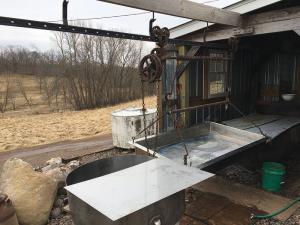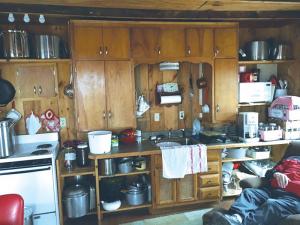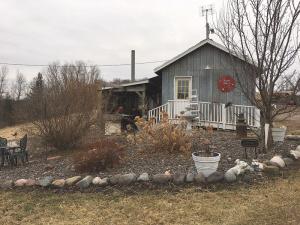2017 - Volume #41, Issue #3, Page #20
[ Sample Stories From This Issue | List of All Stories In This Issue | Print this story
| Read this issue]
Family Cooks Maple Syrup In Home-Built “Sugar Shack”
 |
 |
 |
The “Sugar Shack”, as he calls it, is a small wooden 14 by 10-ft. building with kitchen and dining facilities inside, where the family eats meals during the maple syrup cooking season. An attached garage-like structure stands outside and is where the sap is cooked into syrup.
The cooking system includes a wood-fired stove and a 4 by 6-ft., 6-in. deep stainless steel pan, which is moved back and forth on an old barn manure cleaner and track. The pan is supported by a metal bracket and chains that attach to the pan corners. The stove is an old 750-gal. propane tank, cut down on one side to accommodate the pan where the sap is boiled. An old 12-in. dia. silo filling tube is welded to the stove and forms the chimney. An old round bulk milk tank serves as the finishing tank. And off to one side is a 150-gal. round storage tank.
“We built it about 9 years ago, and our family and many relatives have really enjoyed the time we’ve spent here,” says Norenberg. “Most of the construction work was done by my brother-in-law, Duane Meyer. We don’t sell any of the syrup we make, but sometimes we give it away as Christmas gifts. Last year we made 370 pints of syrup, which we split up between 6 different families.”
To build the wood-fired stove, Meyer cut the top half off one side of the propane tank and then welded on a steel plate that the pan sets on. He also cut a couple of doors into the tank to load firewood.
Norenberg says they make the syrup in batches, with 140 to 160 gal. of sap needed to make each batch.
“We collect the sap in 5-gal. containers and pour it into the pan. Once the fire is good and hot, we chain up the pan and roll it down the track and lower it onto the steel plate on the stove. We let the sap in the pan boil down to about 1 in. deep. Then we lift the pan off the stove, roll it down the track to the finishing tank, and open a valve to empty the sap into it. A small fire under the finishing tank does the final cooking. Then we start making another batch.
“The first day of maple syrup season this year we collected 200 gal. of sap, but we can only put 50 gal. into the firebox tank at a time, so the rest goes into the storage tank.”
Norenberg says they can boil down about 10 gal. of sap per hour, so with a 150-gal. storage tank it takes about 18 to 20 hrs. to finish each batch.
The entire setup cost very little to build. “The tracked manure carrier came from an old barn a few miles away,” says Norenberg. “The tin and boards for the building came off a torn-down structure. The windows were recycled after we remodeled our house, and the kitchen cabinets came from my brother and sister-in-law after they remodeled their kitchen. We use an old stove from my sister and brother-in-law to heat the building.”
Contact: FARM SHOW Followup, Barry Norenberg, 20591 Pickle Lake Road, Grantsburg, Wis. 54840 (ph 715 327-4345; barry.norenberg@bosch.com).

Click here to download page story appeared in.

Click here to read entire issue
To read the rest of this story, download this issue below or click here to register with your account number.




